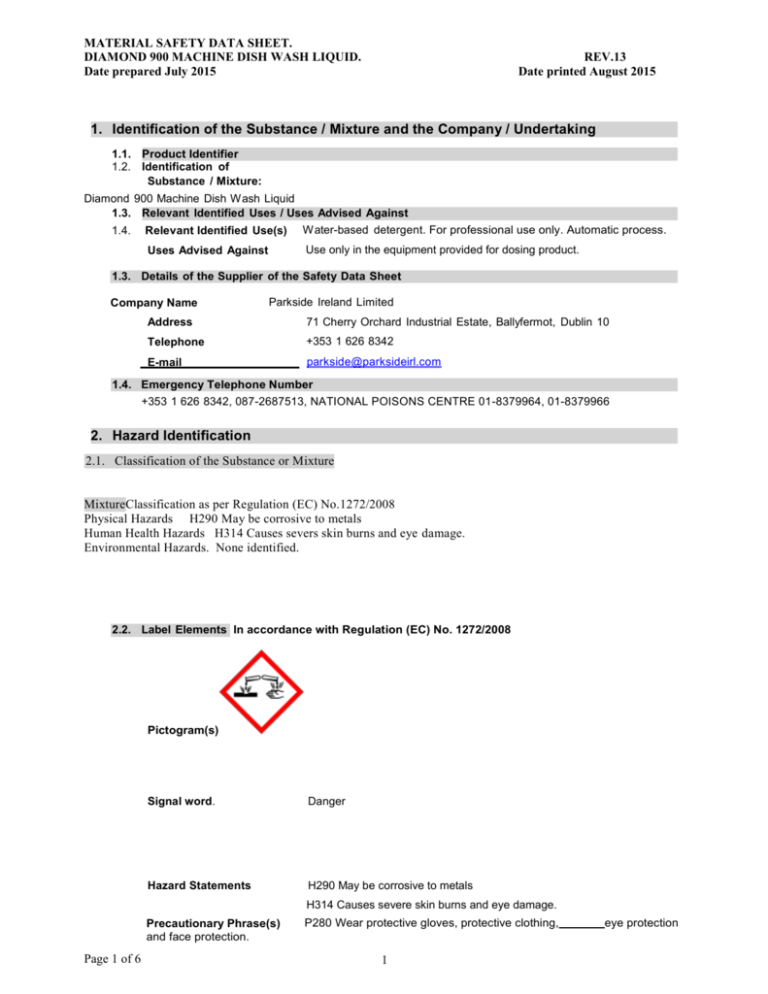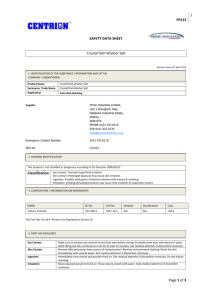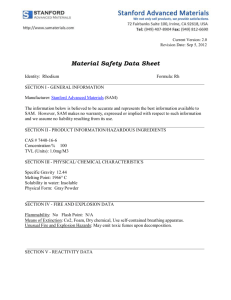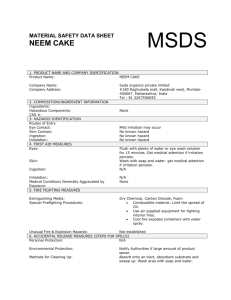Diamond 900 Machine Dish Wash Liquid - MSDS
advertisement

MATERIAL SAFETY DATA SHEET. DIAMOND 900 MACHINE DISH WASH LIQUID. Date prepared July 2015 REV.13 Date printed August 2015 1. Identification of the Substance / Mixture and the Company / Undertaking 1.1. Product Identifier 1.2. Identification of Substance / Mixture: Diamond 900 Machine Dish Wash Liquid 1.3. Relevant Identified Uses / Uses Advised Against 1.4. Relevant Identified Use(s) Water-based detergent. For professional use only. Automatic process. Use only in the equipment provided for dosing product. Uses Advised Against 1.3. Details of the Supplier of the Safety Data Sheet Company Name Parkside Ireland Limited Address 71 Cherry Orchard Industrial Estate, Ballyfermot, Dublin 10 Telephone +353 1 626 8342 E-mail parkside@parksideirl.com 1.4. Emergency Telephone Number +353 1 626 8342, 087-2687513, NATIONAL POISONS CENTRE 01-8379964, 01-8379966 2. Hazard Identification 2.1. Classification of the Substance or Mixture MixtureClassification as per Regulation (EC) No.1272/2008 Physical Hazards H290 May be corrosive to metals Human Health Hazards H314 Causes severs skin burns and eye damage. Environmental Hazards. None identified. 2.2. Label Elements In accordance with Regulation (EC) No. 1272/2008 Pictogram(s) Signal word. Danger Hazard Statements H290 May be corrosive to metals H314 Causes severe skin burns and eye damage. Precautionary Phrase(s) and face protection. Page 1 of 6 P280 Wear protective gloves, protective clothing, 1 eye protection MATERIAL SAFETY DATA SHEET. DIAMOND 900 MACHINE DISH WASH LIQUID. Date prepared July 2015 REV.13 Date printed August 2015 P303+P361+P353 IF ON SKIN (or hair) , Remove immediately all contaminated clothing. Rinse skin with water. P305+P351+338. IF IN EYES, Rinse cautiously with water for several minutes. Remove contact lenses, if present and easy to do. Continue rinsing. P310 Immediately call a POISON CENTRE or doctor. P390 Absorb spillage to prevent material damage 2.3. Other Hazards No other hazards have been identified. 3. Composition / Information on Ingredients 3.1. Substances Not applicable 3.2. Mixtures This product includes the ingredients listed below: Name CAS No. EC No. Content Classification [a] Regulation (EC) 1272/2008 Tetrasodium ethylene diamine tetraacetate 64-02-8 200-573-9 <5% H302,H318,H332 Sodium silicate 1344-09-8 2156874 <5% H290,H314, H318 Sodium hydroxide 1310-73-2 215-185-5 5-15 % H314 Type 1 [a] The symbols used are explained in Section 16. 4. First Aid Measures 4.1. Description of First Aid Measures Eye contact Wash immediately, abundantly and thoroughly with low-pressure water, for at least 15 minutes . Remove contact lenses if possible and easy to do .If any undesirable symptoms persist, obtain professional assistance from a doctor. Inhalation Remove casualty from exposure while also ensuring one's own safety in doing so. Consult a doctor in case of complaints if there are any undesirable symptoms. Ingestion Wash mouth and throat with water and give water to drink. Do not induce vomiting. Obtain professional assistance from a doctor if there are any undesirable symptoms. Skin contact Remove all contaminated clothes and footwear immediately unless stuck to skin. Rinse with plenty of soap and water. 4.2. Most Important Symptoms and Effects, both Acute and Delayed See Section 11. Exposure to skin or eyes can result in severe burns and irritation. 4.3. Indication of any Immediate Medical Attention and Special Treatment Needed Treat according to symptoms. 5. Fire fighting Measures 5.1. Extinguishing Media Suitable extinguishing media: Suitable extinguishing media for the surrounding fire should be used. Use water spray to cool containers. 5.2. Special Hazards Arising from the Substance or Mixture Exposure hazards: Page 2 of 6 During fire or if heated, toxic gases, CO (Carbon Monoxide) and CO 2 2 MATERIAL SAFETY DATA SHEET. DIAMOND 900 MACHINE DISH WASH LIQUID. Date prepared July 2015 REV.13 Date printed August 2015 (Carbon Dioxide) may be formed. 5.3. Advice for Fire-fighters Advice for Fire-fighters: Wear self-contained breathing apparatus. W ear protective clothing to prevent contact with skin and eyes. 6. Accidental Release Measures 6.1. Personal Precautions, Protective Equipment and Emergency Procedures Mark out the contaminated area with signs and limit access to authorised personnel. Do not attempt to take action without suitable protective clothing – see Section 8. Turn leaking containers leak-side up to prevent the escape of liquid. 6.2. Environmental Precautions Do not allow product to reach sewage system or any water course. Prevent from spreading (by using oil barriers, for example). 6.3. Methods and Material for Containment and Cleaning Up In the event of spillage, take up bulk with an inert absorbent. Transfer to a container for disposal by an appropriate method. Close the container securely and label the container. 6.4. Reference to Other Sections See section 1 for emergency contact information See section 8 for information on personal protection equipment See section 13 for additional waste treatment information. 7. Handling and Storage 7.1. Precautions for Safe Handling Avoid contact with eyes, skin and clothing. Keep containers closed. 7.2. Conditions for Safe Storage, Including any Incompatibilities Store in original containers, at a temperature of 5–40 ºC. Keep containers closed. Store in a cool, well ventilated area. 7.3. Specific End Use(s) See Section 1.2. 8. Exposure Controls 8.1. Control Parameters Name CAS No. EC No. OE Value (8-hour OE Limit Value (15-minute reference period) ppm Sodium Hydroxide 1310-73-2 mg/m 3 reference period) ppm 215-185-5 mg/m 3 2 8.2. Exposure Controls Page 3 of 6 Engineering measures Ensure that there is sufficient ventilation of the areas in which the product is stored and used. Use only in the dosing systems provided for dispensing product into dish wash machine. Use gloves and eye protection when connecting to the dosing equipment. Respiratory Protection Not required if workspace is well-ventilated. Self-contained breathing apparatus must be available in case of an emergency. Hand Protection Protective gloves (EN 374). Eye Protection Safety eyewear (EN 166). Provide eye wash stations. Skin Protection Protective clothing and boots. 3 MATERIAL SAFETY DATA SHEET. DIAMOND 900 MACHINE DISH WASH LIQUID. Date prepared July 2015 Hygiene Protection REV.13 Date printed August 2015 Wash hands after contact with product and before commencement of other activities. 9. Physical and Chemical Properties 9.1. Information on Basic Physical and Chemical Properties Appearance Mobile liquid at ambient temperatures. Colour Clear, pale straw. Odour Slight Solubility (water) Highly soluble Solubility (fat) Sparingly soluble pH (i00%) 13 – 14 Melting point < 0ºC Boiling point/boiling > 100ºC Relative Density 1.10 – 1.12 (20ºC) Vapour pressure @ 20 ºC Not determined Flash Point Autoflammability > 100° C Not autoflammable Flammability (solid, gas) Not flammable Partition coefficient (n- octanol/water) Not determined Oxidising Properties Not oxidising Explosive Properties Not determined 9.2. Other Information No further relevant information available. 10. Stability and Reactivity 10.1. Reactivity No hazardous reaction is anticipated if the instructions/indications for handling and storage (see Section 7) are respected. 10.2. Chemical Stability This mixture is stable under the recommended handling and storage conditions described in Section 7. 10.3. Possibility of Hazardous Reactions See Section 10.1 and 10.2 10.4. Conditions to Avoid Avoid freezing or boiling temperatures. 10.5. Incompatible Materials Acids. 10.6. Hazardous Decomposition Products Thermal decomposition may result in the release/formation of: – carbon monoxide (CO) – carbon dioxide (CO2) 11. Toxicological Information 11.1. Information on Toxicological Effects Symptoms / Routes of Exposure Page 4 of 6 Eye Contact There may be pain and redness. Eyes may water. Vision may be blurred. Ingestion There may be soreness and redness of the mouth and throat. Nausea and stomach pain may occur. 4 MATERIAL SAFETY DATA SHEET. DIAMOND 900 MACHINE DISH WASH LIQUID. Date prepared July 2015 REV.13 Date printed August 2015 Inhalation There may be irritation of the throat with a feeling of tightness in the chest. Skin Contact Likely to cause irritation to skin and mucous membranes. 12. Ecological Information 12.1. Toxicity Negligible ecotoxicity. 12.2. Persistence and Degradability Easily biodegradable 12.3. Bioaccumulative Potential Not expected to bioaccumulate. 12.4. Mobility in Soil Readily absorbed into soil. 12.5. Results of PBT and vPvB Assessment PBT Not applicable for this product vPvB Not applicable for this product. 12.6. Other Adverse Effects No known significant effects or critical hazards. 13. Disposal Considerations 13.1. Waste Treatment Methods Avoid pouring into drains or waterways. Avoid contaminating the ground or water with waste. Where practical, waste or surplus material should be recovered and recycled. When disposing of waste or surplus material avoid contact with the eyes and skin. See Section 8 for personal protective equipment. 14. Transport Information 14.1. UN number UN 1824 14.2. UN proper shipping name Sodium Hydroxide Solution. 14.3. Transport hazard class(es) 8 ADR/RID 14.4. Packing group 14.5. Environmental hazards See section 12. 14.6. Special precautions for user Not applicable. Page 5 of 6 5 MATERIAL SAFETY DATA SHEET. DIAMOND 900 MACHINE DISH WASH LIQUID. Date prepared July 2015 REV.13 Date printed August 2015 14.7. Transport in bulk according to Annex II of MARPOL73/78 and the IBC Code Not applicable. Product is not transported in bulk. 15. Regulatory Information 15.1. Safety, Health and Environmental Regulations / Legislation Specific to the Substance or Mixture Not applicable 15.2. Chemical Safety Assessment A chemical safety assessment has not been carried out for the substance or the mixture by the supplier. 16. Other Information Explanation of Changes Made in Revising Document Revisions to this document are marked with the symbol: Relevant Legislation Regulation (EC) No 1907/2006 of the European Parliament and of the Council of 18 December 2006 concerning the Registration, Evaluation, Authorisation and Restriction of Chemicals (REACH) and subsequent amendments. Regulation (EC) No. 1272/2008 on classification, labelling and packaging of substances and mixtures (CLP) and subsequent amendments. Explanation of Hazard Statements used in Section 3 Statement Explanation H290 May be corrosive to metals H302 Harmful if swallowed H314 Causes severe skin burns and eye damage H318 Causes serious eye damage H332 Harmful if inhaled. Use of This Safety Data Sheet This Safety Data Sheet complements and should be used in conjunction with Technical Data Sheets. The information and recommendations given above are, to the best of the company's knowledge and belief, accurate and reliable as of the date issued, but are offered without guarantee or warranty. They relate to the specific material designated and may not be valid for such material used in combination with any other material or in any process. Conditions of use of the material are under the control of the user, therefore it is the user's responsibility to satisfy himself as to the suitability and completeness of this information for his own particular use. It is also the responsibility of the user to take all precautions required in handling this material. The attention of the user is drawn to possible risks which may be incurred by using the product for any purpose other than that for which it is intended. The provision of this Safety Data Sheet does not exonerate the user from appraising himself of all regulations governing his activities; for this he is solely responsible. REGISTERED WITH THE POISONS UNIT , BEAUMONT HOSPITAL, DUBLIN. Page 6 of 6 6








